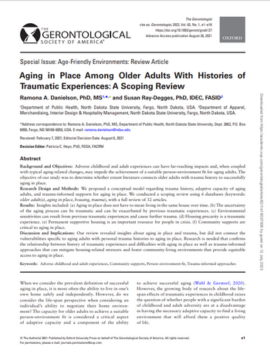Aging in Place Among Older Adults With Histories of Traumatic Experiences: A Scoping Review
This scoping review found 32 articles that in some way bridged aging in place and trauma.
Author: Ramona A Danielson, PhD, MS and Susan Ray-Degges, PhD, IDEC, FASID
Publication Date: January 14, 2022
Description:
Background and Objectives
Adverse childhood and adult experiences can have far-reaching impacts and, when coupled with typical aging-related changes, may impede the achievement of a suitable person–environment fit for aging adults. The objective of our study was to determine whether extant literature connects older adults with trauma history to successfully aging in place.
Research Design and Methods
We proposed a conceptual model regarding trauma history, adaptive capacity of aging adults, and trauma-informed supports for aging in place. We conducted a scoping review using 6 databases (keywords: older adult(s), aging in place, housing, trauma), with a full review of 32 articles.
Results
Insights included: (a) Aging in place does not have to mean living in the same house over time. (b) The uncertainty of the aging process can be traumatic and can be exacerbated by previous traumatic experiences. (c) Environmental sensitivities can result from previous traumatic experiences and cause further trauma. (d) Housing precarity is a traumatic experience. (e) Permanent supportive housing is an important resource for people in crisis. (f) Community supports are critical to aging in place.
Discussion and Implications
Our review revealed insights about aging in place and trauma, but did not connect the vulnerabilities specific to aging adults with personal trauma histories to aging in place. Research is needed that confirms the relationship between history of traumatic experiences and difficulties with aging in place as well as trauma-informed approaches that can mitigate housing-related stressors and foster community-living environments that provide equitable access to aging in place.
Access: Free
Keywords: Adverse childhood and adult experiences, community supports, person-environment fit, trauma-informed approaches



